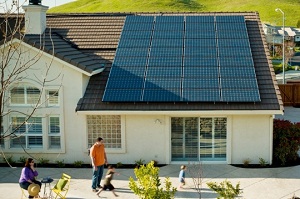Week in review: More companies surpass 1 GW mark in the US
 At least three PV manufacturers have now surpassed 1 gigawatt of installations in the Americas. And while two of them, SunPower and First Solar, which have built and are building some of the world’s largest PV farms ever conceived (thus far) domestically, the newest entrant to the 1 gigawatt club is China’s Yingli. In the U.S., one of the key issues remains funding sources for projects—large and small. But one of the popular mechanisms for incentivizing solar in Europe—feed-in tariffs (FiTs) have had a hard time gaining traction in the U.S. Meanwhile another potential source of funding called crowdsourcing (akin to bonds) is increasingly taking off for small to mid-sized commercial scale projects.
At least three PV manufacturers have now surpassed 1 gigawatt of installations in the Americas. And while two of them, SunPower and First Solar, which have built and are building some of the world’s largest PV farms ever conceived (thus far) domestically, the newest entrant to the 1 gigawatt club is China’s Yingli. In the U.S., one of the key issues remains funding sources for projects—large and small. But one of the popular mechanisms for incentivizing solar in Europe—feed-in tariffs (FiTs) have had a hard time gaining traction in the U.S. Meanwhile another potential source of funding called crowdsourcing (akin to bonds) is increasingly taking off for small to mid-sized commercial scale projects.
China’s Yingli Green Energy said it has now a full gigawatt of its PV modules to the Americas, a feat that likely only First Solar, SunPower and perhaps SolarWorld have surpassed. The amount of shipments to the U.S. also represents a significant percentage of Yingli’s overall production, which as the world’s largest PV manufacturer is producing more 2.45 gigawatts of PV modules on an annual basis. The company said it has delivered PV modules for more than 30,000 PV projects in the Americas and Caribbean.
While Yingli’s inroads to the U.S. are gaining strength, two of the U.S.’s leading, vertically integrated PV manufacturers, SunPower and First Solar, are increasingly looking towards the international market. First Solar recently partnered with GE to help share GE’s thin-film CadTel technology and now are partnering on project purchases as wel through GE Financial Services, which led a group of investors to purchase 50 megawatts of First Solar projects in Canada. First Solar is increasingly looking internationally to develop PV projects in markets where solar can compete with other power sources.
Similarly SunPower is also pursuing solar in more countries. This past week the crystalline silicon PV manufacturer announced that it partnered with Australia’s Community First Credit Union to offer homeowners low to no up-front cost loans to homeowners in Australia. The loans will allow the homeowners to own their PV system outright and have a repayment period of 10 years. The offering gives Australian homeowners who want to pursue solar a new option, making it easier for them to go solar.
FiTs have been a popular incentive scheme in Europe spurring, for instance Germany’s solar spree, and in Japan, where the FiT is helping make it one of the largest solar markets in 2013. However, the option, under which all power produced by an PV array is purchased by the utility—usually at a premium to current electric rates—hasn’t taken off in the U.S. because no national policy has supported it. And now, at least one utility, Arizona Public Service (APS) has proposed an FiT that The Alliance for Solar Choice (TASC), a solar advocacy group, say would put to much burden on ratepayers.
Another funding opportunity to get solar projects going is the one being pioneered by Solar Mosaic. The company is using the idea of crowdfunding (basically selling bonds or securities to support the project). Its latest endeavor is crowdfunding 12 megawatts of PV at the Dix unit of Joint Base McGuire-Dix-Lakehurst in New Jersey.The company plans to install PV on 547 homes on the base.




